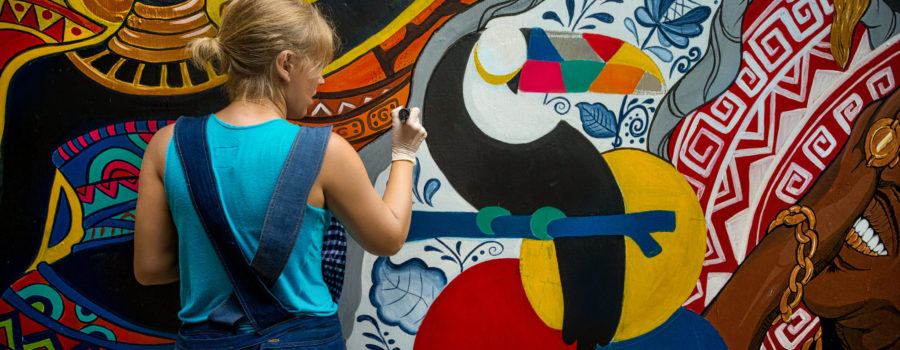Is there copyright in street art? The answer to this question is YES, there is copyright in street art.
Before with dive into this post, let’s be clear of what this is NOT about. This post does not discuss the legality of street art. Some street or urban art is sanctioned or commissioned, while other forms of this art are not. This post IS about the rights the artist could have regarding his visual expression of art.
Does street art meet the copyright requirements?
Street art is a form of visual art. Visual art is protected by copyright. For a work to qualify for copyright, it has to meet two simple requirements. These are: (i) have a minimum of creativity, and (ii) be fixed to a tangible medium of expression.
Street art meets these requirements. For the most part, it is highly creative. And the wall or side of a building is a tangible medium of expression. So, once on the wall, the work is fixed to a tangible medium. When the work meets these two requirements, it can have copyrights.
Whether or not street art is subject to copyright and if the artist can enforce copyright over an unsanctioned visual work of art has been discussed by the courts in various instances. A definite and final rule has yet to be achieved. What is evident, is that artists are gaining headway. In the last years, the courts have tended to move in favor of copyright. Jonathan Bailey, discusses some of these instances in is his post Graffiti: At the Edge of Copyright.
Why is this important? Well, when a work is subject to copyright, the copyright owner has exclusive rights over the work. These rights give the copyright owner control over the commercial use and exploitation of the work. In our post, What is a copyright?, we set out these rights. In essence they are the right to:
- Reproduce a work.
- Distribute a work.
- Create a derivative work.
- Publicly perform the work.
- Publicly exhibit the work.
What does this mean?
What does this mean? As street art continues to grow and gain in popularity, there also grows commercial value. If the work qualifies for copyright, then the copyright owner has leverage over the commercial exploitation of the work.
This means that if someone, other than the copyright owner, commercially exploits the work for their own benefit, the copyright owner could have a legal claim. But, what if the work was not the primary focus and the appearance of the work was incidental in an ad campaign for a clothing company? The clothing company could claim that the use of the work in the ad campaign was fair use. The good side to this, for the court to determine it is fair use, it must first determine the work qualifies for copyright. The flip side, if the court determines it is fair use, then no monies are awarded to the copyright owner. (See our post on The fair use defense and copyrights.) Either way, if it escalates into a legal suit it will be for the court to decide.
Can someone paint over it?
Can someone paint over it? Yes they can. The five exclusive rights granted under copyright law do not grant the right to preclude others from painting over the work. In essence, the owner of the building can paint over it.
There are jurisdictions which grant moral rights to artists. This is a set of rights separate from copyrights. Puerto Rico is such a jurisdiction with the Moral Rights Act. In the United States, this concept was introduced through the Visual Artists Rights Act of 1990, known as VARA. Through VARA, moral rights are limited to certain visual works of art.
If the street art is subject to moral rights, then the artist can claim the right to attribution and the integrity of the work, among other things. The right to the integrity of the work, grants the right to (i) prevent any intentional distortion, mutilation, or other modification of that work which would be prejudicial to the artist’s honor or reputation, and (ii) prevent any destruction of a work of recognized stature. With this, the artist can effectively prohibit or impede others from destroying, mutilating or altering the work. In essence, the artist could prevent someone from painting over the street art.
As urban artists and street art continue to grow and gain recognition, so will the headway the make in regards to their copyrights and moral rights.
Author: Patricia Ramírez Gelpí, J.D., LL.M.
Image: Wallenrock/Shutterstock.com





